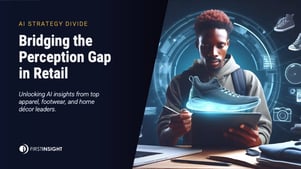Retailers are not failing at AI because the technology isn’t ready—they’re failing because they think they are. Every major retailer wants to harness artificial intelligence to make smarter, faster, and more customer-centric decisions. This ambition is correct; the execution, however, is often flawed from its inception. Billions of dollars are being poured into in-house AI projects that never scale, fail to integrate across departments, and ultimately, never deliver a return on investment. The "we can build it ourselves" mindset, while seemingly a demonstration of capability, has become a significant liability.
The problem is that this internal confidence often overlooks the immense complexity of building, deploying, and maintaining enterprise-grade AI. As Greg Petro, CEO of First Insight, explained during a Tech Fest’s Retail Rewired panel, the failure often starts before the first line of code is ever written. It begins with a fundamental misunderstanding of what it takes to succeed with AI in a retail environment.
The Build-vs-Buy Trap
Large organizations frequently default to building technology internally, assuming their access to data, talent, and substantial resources guarantees success. This assumption is the first pitfall in the build-versus-buy decision. The very size of the organization, which should be an asset, often becomes the first major stumbling block. While large retailers have the budget for ambitious projects, they are also saddled with the bureaucracy that accompanies scale. Internal politics, departmental silos, and slow approval processes kill the speed and alignment necessary for AI initiatives to succeed.
In contrast, smaller or more agile brands that choose to partner with external specialists can move faster, adopt proven technologies, and begin seeing returns much sooner. "Build" projects tend to sprawl, with multiple departments owning different pieces of the puzzle and no single, accountable owner. This fragmentation leads to solutions that are disconnected and ineffective. Meanwhile, a specialized partner focuses on solving a single, validated problem at scale, bringing a level of expertise that is nearly impossible to replicate in-house.
The Hidden Costs of Building In-House
The decision to build an AI solution internally carries significant hidden costs that extend far beyond initial budget allocations. These costs manifest in four critical areas:
- Speed to Market: The technology landscape evolves at an astonishing pace. By the time an internal team manages to build and deploy a solution, the underlying technology has often advanced, rendering their creation obsolete before it can deliver value. In retail, speed is leverage. A delay of months or even years means missing trends, over-investing in the wrong products, and ceding ground to more agile competitors.
- Talent Acquisition and Retention: Recruiting and retaining top AI engineers is a full-time business, not a side project for a retail company. The most skilled AI professionals are drawn to organizations where their work is central to the company’s mission, not a support function. Retailers find themselves in a perpetual and costly war for talent against tech giants, a battle they are rarely equipped to win.
- Complex Integration: Retail data is notoriously fragmented, residing in disparate systems like POS, e-commerce platforms, CRM, and PLM. Internal projects consistently underestimate the complexity of cleaning, standardizing, and connecting these data sources. Without a unified data foundation, any AI model will be ineffective.
- Change Management: Even when the technology itself is functional, its adoption can fail without proper organizational alignment. A new tool is useless if teams are not prepared, trained, or incentivized to use it. As Petro noted, true success requires a shared commitment from the start. "They have to go into it with an alignment on a partnership level—if we find the gold, we’re going to follow this path. And that doesn’t always happen."
The Partnership Advantage
External AI partners offer a strategic alternative, bringing focus, objectivity, and decades of domain-specific learning to the table. These partners have already navigated the challenges of data integration, model development, and scalable deployment. They provide a proven engine, allowing retailers to avoid the costly and time-consuming process of reinventing the wheel.
"Companies like ours have nearly two decades of working on one specific thing—turning consumer data into predictive value," Petro explained. This deep specialization is a powerful advantage. Partnerships can reduce internal politics by introducing an objective third party, accelerate the timeline to prove value, and provide access to more sophisticated models and cleaner data frameworks than an in-house team could develop on its own. For example, by partnering with First Insight, retailers like David's Bridal were featured in a Gartner case study for having been able to accelerate their decision-making and align their product offerings more closely with consumer demand, demonstrating the tangible benefits of a strategic partnership.
Integration: The Overlooked Success Factor
The success of any AI initiative hinges on the quality of the data it is fed. AI can’t function effectively without the right data infrastructure and a clear taxonomy. Too often, retailers become fixated on the volume of their data without considering its readiness. As Petro astutely pointed out, "AI will always give you an answer—whether it’s right or not."
Feeding bad or unstructured data into an AI model doesn’t just waste money; it produces incorrect answers faster, leading to poor strategic decisions. An algorithm trained on incomplete or inconsistent data will generate flawed predictions about consumer trends, pricing, and inventory. This reinforces bad decisions with a false sense of data-driven confidence. Before embarking on any AI project, retailers must first invest in creating a clean, structured, and governed data ecosystem. The readiness of your data, not just its volume, is the true prerequisite for success.
Building Smarter, Not Harder
Successfully integrating AI does not require a "big bang" rollout. The most effective approach is to start small, partner strategically, and integrate intentionally. Retailers can achieve significant wins by focusing on solving specific, high-value problems first and then expanding from there.
"AI doesn’t have to start with heavy investments—it can grow," Petro concluded. "It just has to be aligned appropriately." To get it right, organizations should follow these steps:
- Define Success Early: Clearly identify the specific business problem you are trying to solve and what a successful outcome looks like.
- Choose Partners Wisely: Look for partners with proven results, deep domain knowledge in retail, and a clear understanding of your business needs.
- Prepare Your Data: Invest the time and resources to structure, clean, and govern your data before deploying any AI tools.
- Plan for Adoption: Ensure leadership alignment and user readiness from the beginning to drive successful implementation and long-term value.
Bridge the Gap Between AI Promise and Performance
Retailers that treat AI as a do-it-yourself project risk wasting invaluable time, resources, and internal trust. The belief that in-house development is the superior path is a costly mistake that puts them at a competitive disadvantage.
Conversely, those that partner smartly will accelerate their access to critical insights, improve decision accuracy, and drive profitability. The goal is not to build AI but to leverage it effectively. By collaborating with specialists, retailers can bypass the common pitfalls of in-house development and focus on what they do best: serving their customers.
At First Insight, we have spent nearly two decades helping retailers bridge the gap between AI promise and performance—turning consumer data into predictive insights.
Ready to see what that looks like in action? Book a complimentary 30-minute call below.

















